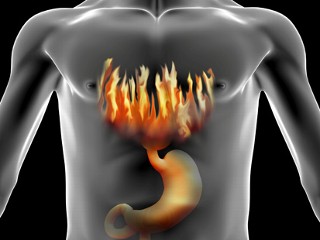Gastroesophageal reflux disease (GERD) is a condition in relation to the digestive system, where the content from not only the stomach, but also from the gall bladder and pancreas, back-flow up into the esophagus. This disease causes various symptoms that people might miss out and with time as the disease progresses, the symptoms might become bothersome or severe. It is indeed a very common phenomenon among the public. Words like “heart burn†or “acid reflux†are well known complaints that we often use. But what is really going on?
 How does GERD occur?
How does GERD occur?
Lower Esophageal Spincter Dysfunction
The gastrointestinal tract starts from our mouths. From there food enters and through the esophagus, food bolus goes into the stomach where further digestion and absorption occur.  Right at the juncture between the esophagus and the stomach, there is a “muscular gateâ€, termed as the lower esophageal sphincter. This sphincter is formed by involuntary muscles that functions to prevent food particles in the stomach from flowing back into the esophagus. When this lower esophageal sphincter is incompetent or impaired, the gastric content is refluxed into the esophagus and possibly even into the throat.
Right at the juncture between the esophagus and the stomach, there is a “muscular gateâ€, termed as the lower esophageal sphincter. This sphincter is formed by involuntary muscles that functions to prevent food particles in the stomach from flowing back into the esophagus. When this lower esophageal sphincter is incompetent or impaired, the gastric content is refluxed into the esophagus and possibly even into the throat.
Hiatal Hernia
The other cause would be due to a type of hernia, called hiatal hernia. This type of hernia refers to the protrusion of part of the stomach,  particularly the upper part of the stomach into the thoracic cavity through a weak point at the diaphragm. Although not all patients with hiatal hernia will have GERD symptoms, but it is proven that it is one of the contributing factors to GERD. When the hernia is not corrected, with time, the hernia would impair the lower esophageal sphincter and eventually cause the gastric content to be trapped and refluxed through the sphincter into the esophagus.
particularly the upper part of the stomach into the thoracic cavity through a weak point at the diaphragm. Although not all patients with hiatal hernia will have GERD symptoms, but it is proven that it is one of the contributing factors to GERD. When the hernia is not corrected, with time, the hernia would impair the lower esophageal sphincter and eventually cause the gastric content to be trapped and refluxed through the sphincter into the esophagus.
Basically, when the acidic content from the stomach, together with the bile and pancreatic secretions reflux into the esophagus and into the throat, inflammation results. The backwash of this acidic content in the esophagus can result in eroding of the lining of the esophagus which causes discomfort to the patient, hence the sensation of heartburn.
The other factors that aggravate the acid reflux include the following:
- Acidic food and beverages – coffee, tea, citrus fruits and juices
- Alcohol
- Smoking
- Poor sleep hygiene – eating just before or within 2 hours before sleep, sleeping flat without the support of a pillow
- Heavy diet – Fatty food, heavy meals
 What are the signs and symptoms of GERD?
What are the signs and symptoms of GERD?
Heartburn
This is an unpleasant sensation of burning in the heart. Such discomfort can mimic a heart attack. This sensation is due to the acidic inflammation and erosion of the esophagus.

Sore throat and coughing
When the inflammation spreads to the throat, in the larynx, it causes irritation to the throat and results in sore throat. Patients with chronic or frequent sore throat commonly missed this symptom as a sign of GERD. With time, patient’s vocal cord is affected and hoarseness of voice arises.
Difficulty in swallowing
Aside from just sore throat, patient might have problem swallowing food or drinks. Similarly, this is due to the inflammation along the throat and esophagus.

Regurgitation
Differing from vomiting, regurgitation is when the gastric content surges back, upwards into the throat, but not to the point of being ejected out of the mouth. This occurs because of the incompetency of the lower esophageal sphincter, allowing backflow of stomach content into the esophagus. Patient would taste sour substance and/or the food particle that was just ingested not long before.
Sensation of something in the back of the throat
This is quite a typical complaint by many GERD patients, “I feel that there is a lump at the back of my throatâ€. Chronic inflammation due to the acid reflux causes this symptom.
Who are at risk?
GERD can affect anybody, of any age. Even in young children, the acid reflux can cause the inflammation and infection to the throat. Thereafter, the infection ascends into the ears through the Eustachian tube which is in connection from the throat, resulting in otitis media – ear infection.
What test would the doctor do to diagnose GERD?
Upper esophago-gastroduodenoscopy
An endoscopy of the upper gastro-intestinal tract allows the physician to have a clear view of the lining from the throat to the esophagus, including the integrity of the lower esophageal sphincter and the state of the stomach.
This is a diagnostic procedure for GERD. However, not everybody can afford this procedure. Sometimes, a skillful physician would be able to pick up the diagnosis clinically through good history-taking from the patient and physical examination.
